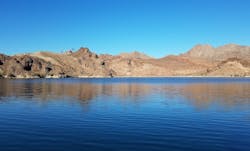USGS Study Examines Baseflow Decline to Lower Colorado River Basin
In a recent USGS study, it was determined that the hot and dry future climate may lead to total baseflow delivered to the Lower Colorado River Basin declining by up to 33% by the 2050s.
The study also suggests that this decline may increase in the near future by 6% under a warm/wet climate. The study provides the first estimates of projected baseflow changes from 1984 to 2012, to thirty-year periods centered around 2030, 2050, and 2080.
Baseflow is estimated to contribute over 50% of the total streamflow in the Upper Colorado River Basin, according to USGS. The study tested how warm/wet, median, and hot/dry future climate scenarios affect baseflow in the basin using a hydrologic model. The study’s results show that the largest declines in baseflow may occur in the headwater streams and that changes in high elevation hydrology have impacts on basin-wide water availability.
According to the study, USGS hypothesizes that baseflow loss during in-stream transport is projected to increase by 1 to 5%, affecting both human and ecological water users.
“Many studies project streamflow and runoff response to climate change in the Upper Colorado River Basin, but this is the first to look at the baseflow component of total streamflow,” said USGS hydrologist Olivia Miller, lead author of the paper, reported American Geophysical Union (AGU). “Understanding how baseflow may respond to climate change is particularly important for water managers when it comes to ensuring sufficient water supply outside the spring runoff period and has critical implications for ecosystem health.”
The study authors determined that baseflow declines may occur due to increases in stream water loss, and the largest declines in the model occur in the Rocky Mountains and in the headwaters of the Green River, reported AGU.
Beyond this study, USGS is measuring and modeling snowpack and linking these results to streamflow. This will be achieved through the USGS Next Generation Water Observing System (NGWOS), and new spatial and temporal snow and streamflow observations are being planned for unmonitored areas to gather more information.
